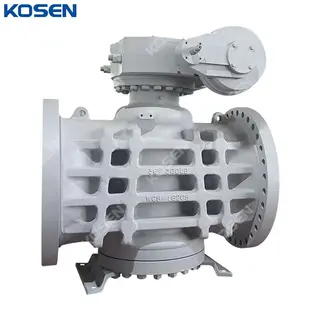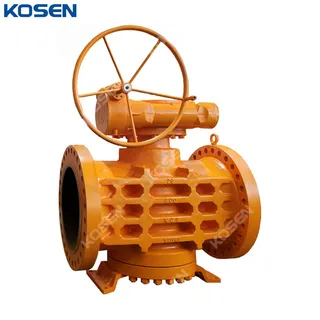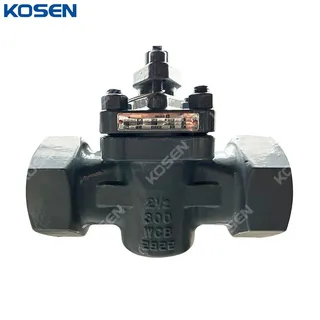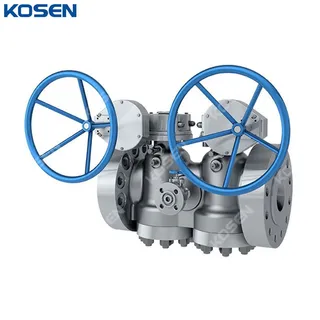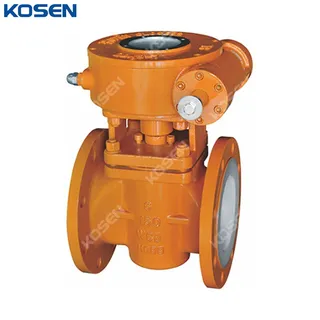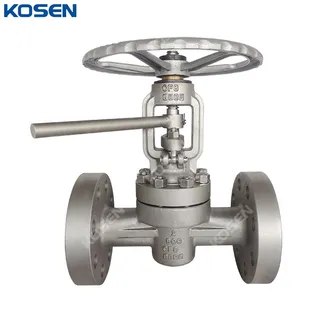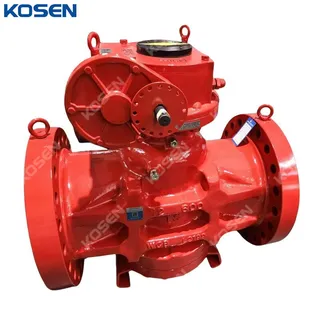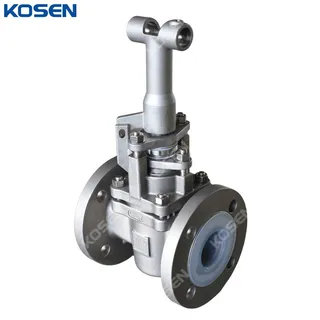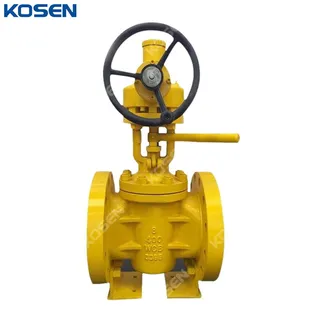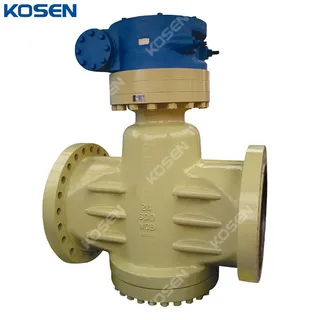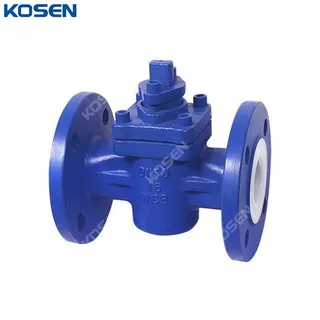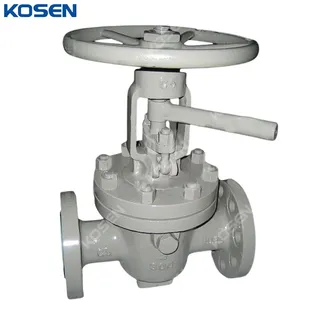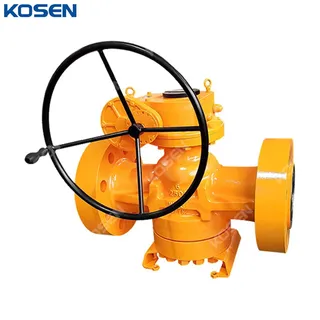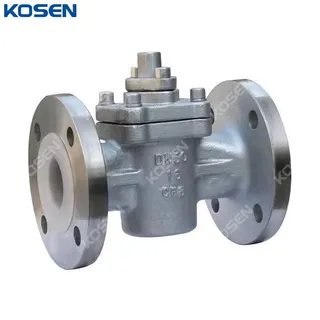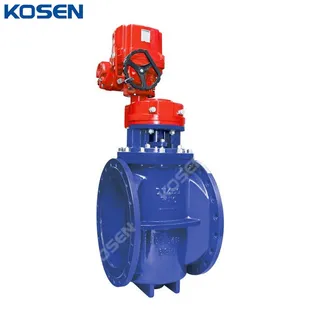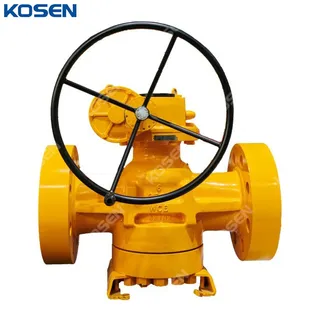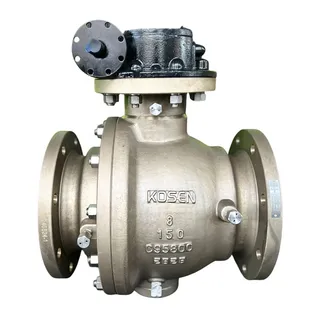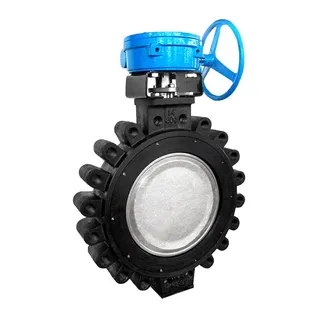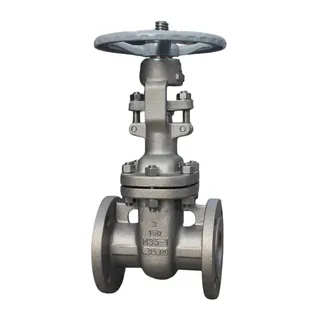The working principle of the plug valve can be analyzed in detail from three aspects: its core components, structural design, and application scenarios.
The core component of the plug valve is the valve plug, often referred to as the "cock". The plug is typically cylindrical or conical in shape and is connected to an external operating mechanism via a valve stem. By rotating the plug, the valve can open or close. When the plug is rotated 90 degrees, its passageway aligns with the valve body's passageway, allowing fluid to flow. Conversely, when the plug rotates to the closed position, the passageways misalign, cutting off the fluid flow. This simple rotational mechanism allows the plug valve to open and close quickly, making it ideal for applications that require frequent operation.
The plug valve features a simple structure with quick opening and closing action and low fluid resistance. The common operation method involves a handle that controls the valve; when the handle is parallel to the valve body, the valve is fully open, and when the handle is perpendicular, the valve is fully closed. Due to its quick operation, the plug valve is generally not used for flow regulation. The open/close action is achieved by rotating the valve plug, which can be cylindrical or conical. The passage in the cylindrical plug is usually rectangular, while in the conical plug, the passage is trapezoidal. This design makes the plug valve light and easy to operate but can result in some fluid resistance.
Traditional plug valves rely on the direct contact between the precisely machined metal plug and the valve body to achieve sealing. This design, however, offers relatively poor sealing performance, requires a higher actuation force, and is prone to wear. Plug valves are typically used in low-pressure and small-diameter applications, especially in systems requiring rapid opening and closing of fluid flow. In environments demanding higher corrosion resistance, the sealing surface design of the plug valve may be modified.
Plug valves are most commonly used to shut off, connect, or divert fluids. Depending on the corrosion resistance and suitability of the plug's sealing surface, they may also be used for throttling. In operation, the plug valve is opened and closed by rotating the plug; turning it clockwise aligns the passage slot with the pipeline, indicating an open position, while a counterclockwise 90-degree rotation aligns the passage slot perpendicular to the pipeline, indicating a closed position. The plug valve's quick and simple operation makes it very common in industrial applications.
Plug valves are classified into several types based on different working principles and design characteristics. Each type is suited for specific working conditions and application scenarios. Common types of plug valves include non-lubricated, oil-lubricated hard-seal, eccentric, and three-way or four-way plug valves.
Non-lubricated plug valves are typically used in low-pressure systems. Unlike lubricated plug valves, they do not have an automatic lubrication system, which makes them prone to wear and damage. However, non-lubricated valves are more economical than lubricated ones, making them suitable for applications that require lower actuator torque.
Oil-lubricated plug valves can be divided into conventional oil-lubricated and pressure-balanced types. These valves use special lubricants injected from the top of the valve body, forming an oil film to reduce the operating torque, improve sealing performance, and extend the valve's lifespan. Oil-lubricated hard-seal plug valves can withstand high working pressures (up to 64 MPa) and operate in high-temperature environments (up to 325°C). Additionally, their maximum diameter can reach 600mm, making them suitable for high-demand working conditions.
The structure of an eccentric plug valve is similar to that of a specialized segmented ball valve. Although the valve body and packing box serve similar functions and have a similar appearance, the axis of the eccentric plug valve is offset from the center position of the seal. In a ball valve, the axis is aligned with the seat to ensure constant contact between the ball and the seat. In an eccentric plug valve, the axis is slightly offset, causing the plug to maintain some distance from the supporting surface before closing, thus reducing wear and extending the valve's lifespan.
Three-way and four-way plug valves are widely used to alter the direction of fluid flow or distribute media, particularly in complex process systems. Depending on the working conditions, soft-sealed liners or soft/hard-sealed lift plug valves may be chosen. These plug valves provide precise control of fluid flow direction, ensuring accurate distribution of the fluid.
Although the design of a plug valve is relatively simple, its functionality and performance are highly dependent on the precise interaction of each component. The main components include the valve body, valve plug, valve seat, packing, driving mechanism, and sealing elements.
Valve Body: The valve body is the main component of the plug valve and is typically manufactured through casting or forging. It provides the channel for fluid flow and includes the seat and guiding features to ensure the valve plug remains in the correct position and moves smoothly within the valve body. The material for the valve body is often selected based on the environmental requirements, with common materials including carbon steel and stainless steel to enhance corrosion resistance and mechanical strength.
Valve Seat: The valve seat is located inside the valve body and works with the valve plug to form the sealing surface, controlling the flow and shutoff of the fluid. The design of the valve seat determines the valve's sealing performance, and it is often made from wear-resistant materials, such as hardened metals, ceramics, or polymers, to ensure long-lasting sealing and durability.
Valve Plug: The valve plug is the core component of the plug valve and is responsible for controlling the degree of valve opening and closing. The plug is typically cylindrical and rotates within the valve body's seat. The plug often has slots or cuts to adjust fluid flow and ensure smooth fluid passage. In the open state, the passageway on the plug aligns with the passage in the valve body, allowing the fluid to flow; in the closed state, the plug's passage misaligns with the valve body's passage, cutting off the flow.
Driving Mechanism: The driving mechanism is responsible for providing the torque to rotate the valve plug, thereby opening and closing the valve. Common driving methods include manual operation (using a handle) and automatic control (using electric motors or pneumatic actuators). Manual plug valves are suitable for applications with lower control requirements, while automatic control actuators are ideal for applications requiring precise adjustments and remote control.
Sealing Elements: Sealing elements are critical to ensuring the valve's sealing performance. Common sealing components include the seat sealing ring and stem sealing devices. The seat sealing ring works with the valve seat to effectively prevent fluid leakage, while the stem sealing device prevents leakage between the valve stem and the external environment. Sealing elements are typically made from high-temperature and corrosion-resistant materials such as PTFE (polytetrafluoroethylene) to ensure the valve's sealing ability and durability.
Plug valves are commonly used fluid control valves, known for their distinctive design and performance, which offer significant advantages in many applications. However, understanding their pros and cons is essential when selecting and using plug valves.
Ease of Operation and Quick Open/Close: Plug valves are easy to operate, offering rapid opening and closing processes. This allows for quick response to fluid flow control requirements, reducing operational time.
Low Fluid Resistance and High Flow Capacity: When open, plug valves offer minimal resistance to fluid flow, making them suitable for high-flow applications and ensuring smooth fluid movement.
Simple Structure and Compact Size: The plug valve features a simple structure and occupies minimal space. Its lightweight design makes installation and maintenance easy.
Excellent Sealing Performance: Plug valves are designed with effective sealing capabilities, particularly when equipped with lined bushings, ensuring superior sealing performance and achieving a "zero-leakage" standard.
No Installation Direction Restrictions: Unlike many other valves, plug valves are not limited by installation direction. The flow direction can be chosen freely, enhancing their adaptability in various systems.
Low Noise and Vibration-Free: Plug valves operate with minimal vibration and low noise levels, making them ideal for environments that require quiet operation.
High Strength and Corrosion Resistance: The valve body of plug valves is made from high-quality cast materials, offering strong resistance to permeation and intergranular corrosion. This feature makes them particularly suitable for the chemical industry, where they can handle highly corrosive media.
Customizable Designs: Plug valves can be customized to meet specific customer requirements, with options for configurations such as three-way, four-way, and five-way designs to fit particular processes.
Superior Wear Resistance and Long Service Life: With good corrosion and wear resistance, plug valves are ideal for handling corrosive, abrasive, viscous fluids, or those containing catalyst particles, offering a long service life.
Lower Manufacturing Tolerances: The plug valve only requires machining on the top surface and flange, while other parts are cast in one piece. This results in lower manufacturing tolerances compared to ball valves, providing a clear cost advantage, especially when high-alloy materials are used.
High Drive Torque Requirements: Due to the design of the sealing surface, plug valves require higher drive torque, especially when equipped with pneumatic actuators. This often necessitates larger actuators and additional components, increasing overall operational costs.
Not Suitable for Frequent Switching: Although plug valves are reliable for shut-off control, they are not ideal for frequent switching applications. Their ability to regulate flow is limited, and they are not designed for high-frequency operation.
Improper Liner Material Selection May Cause Issues: If the liner material is improperly selected or the valve body design does not accommodate the liner's deformation, issues such as swelling of PTFE liners may occur, increasing the required drive torque and reducing valve efficiency.
Plug valves are widely used in various industrial fields, particularly in applications requiring precise control of fluid flow and pressure.
Chemical Industry: In the chemical industry, plug valves control the flow and pressure of various media, ensuring smooth production processes. Their small size, light weight, and ease of maintenance make them suitable for frequent operations in chemical processes.
Oil and Gas Industry: Plug valves play a crucial role in oil extraction, natural gas exploration, and transportation. The compact size and light weight of these valves allow them to adapt well to complex oil and gas environments, and they are easy to maintain.
Water Supply and Drainage: In water supply and drainage systems, plug valves regulate water flow and pipeline pressure. They can handle a variety of media, ensuring the system runs smoothly.
HVAC and Refrigeration: Plug valves are also widely used in HVAC and refrigeration systems to control the flow and pressure of refrigerants, ensuring efficient system operation. Their simple structure and easy maintenance make them well-suited for various refrigerants.
The selection of a plug valve should be based on the operating environment, the properties of the medium, and working conditions. Here are some common selection guidelines:
Multi-Port Plug Valves: Used for media distribution and flow direction change, these valves are suitable for environments with a maximum temperature of 300°C, nominal pressure PN ≤ 1.6 MPa, and nominal diameter not exceeding 300 mm.
Food and Pharmaceutical Industry: For food products (such as milk, juice, beer) and pharmaceutical equipment, a tapered plug valve made of austenitic stainless steel is recommended to ensure corrosion resistance and sealing.
Oil and Gas Industry: For oil field and natural gas extraction and pipeline transportation, tapered plug valves with an oil seal design are recommended, especially when working pressure does not exceed Class 300 and nominal diameter is under 300 mm. For high-pressure conditions (Class 7500, diameter under 900 mm, temperature not exceeding 340°C), oil-seal tapered plug valves are also suitable.
Chemical Industry for Corrosive Media: For handling corrosive media in chemical equipment that requires fast opening and closing, a PTFE-lined tapered plug valve is recommended, particularly for media such as nitric acid. For acetic acid-based media, a Crl8Ni12M02Ti stainless steel plug valve with a PTFE lining is ideal.
HVAC Systems: In gas, natural gas, and heating pipelines with a nominal diameter of up to 200 mm, it is advisable to select a packing-style tapered plug valve for improved sealing and reliability.
Proper installation of plug valves is crucial for ensuring efficient and reliable operation. Here are the key installation steps.
Equipment Check: Clean the internal pipes and inspect the valve and seals for any damage. Ensure that the dimensions match the pipeline.
Actuator Check: Verify that the valve's actuator operates smoothly and is ready for use.
Ease of Operation and Maintenance: Choose a location that allows for easy access for operation and maintenance.
Environmental Conditions: Ensure the installation environment is dry and well-ventilated, avoiding damp or polluted conditions.
Connection Method: Ensure the valve is properly connected to the pipeline to prevent leakage.
Direction Confirmation: Verify the flow direction according to the valve's arrow, ensuring proper alignment with the pipeline.
Fixing the Valve: Secure the valve with flanges or bolts to ensure stable connections.
Operation Check: Test the valve's operation to ensure it opens and closes smoothly.
Sealing Check: Check for leaks and ensure proper sealing.
Trial Run: Gradually open the valve and increase the flow to ensure it operates correctly.
4. Post-Installation Considerations
Regular Checks: Periodically check the actuator and seals, repairing or replacing parts as necessary.
Avoid Hazardous Areas: Keep the valve away from high-temperature, high-pressure, or corrosive environments.
Cleaning Care: When cleaning, avoid damaging the valve's surface to preserve its sealing performance.
Maintenance and Care of Plug Valves
Regular maintenance is essential for ensuring the smooth operation and longevity of plug valves. Here are the main maintenance steps.
Operation Flexibility Check: Ensure the valve can be operated easily without additional force.
Sealing Check: Inspect all sealing points, ensuring no leakage and maintaining a zero-leakage condition.
Corrosion Inspection: Check exposed parts of the valve for rust and address it promptly.
Actuator Inspection: Verify that the actuator is free from water accumulation and lacks lubrication. If needed, add lubricant.
Lubrication of Actuator: If necessary, clean out old lubricant and apply fresh lubricant to all contact surfaces.
Cleaning and Upkeep: Regularly clean the valve's surface and apply paint treatment to protect it from external damage.
Over time, plug valves may experience certain common issues that can affect their operation and sealing performance. Here are some typical problems and solutions:
Difficulty in Opening/Closing: This may be due to a lack of sealing grease on the plug surface. To fix it, add sealing grease and operate the valve. As you operate, the opening will gradually increase until normal operation is restored.
Minor Leakage at Valve Bottom: This can happen if the valve cover is hit during transportation. Tighten the cover screws to restore normal performance.
Internal Leakage: Insufficient sealing grease on the plug surface may cause internal leakage. Add enough grease, ensuring it is evenly distributed. If the problem persists, check the adjustment screw at the bottom center and tighten it.
Minor Leakage Around the Stem: This may be due to insufficient stem packing. Add packing and tighten the packing screw gradually until the leakage is stopped.
Regular maintenance and prompt troubleshooting can keep plug valves in optimal working condition, ensuring reliable performance in various applications.
In conclusion, plug valves offer a straightforward and effective solution for controlling fluid flow, particularly in systems that require quick open/close actions. Their robust design, coupled with features like easy operation, low fluid resistance, and adaptability in various industrial applications, makes them indispensable. However, choosing the right type of plug valve, whether non-lubricated, oil-lubricated, or eccentric, depends on the specific operational requirements, including pressure, temperature, and the nature of the medium. Proper installation, maintenance, and timely selection based on application needs are essential for ensuring the long-term reliability and performance of plug valves in any system.
